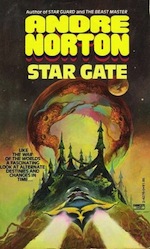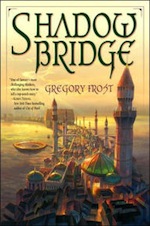I’ve always loved books that take place in unfamiliar worlds, places with no creative or physical boundaries, as wide or wider than our own world. And the more territory that the characters and the reader can explore, the better! So here are five of my favorite books that use unconventional magical or super-science methods of travel.
The Idylls of the Queen by Phyllis Ann Karr (1982)
 Method: Swift travel magic.
Method: Swift travel magic.
Using magic to make travel on horseback faster is an old-school method, and I think it’s used especially well in The Idylls of the Queen, a magical Arthurian murder mystery. Queen Guenevere has been accused of murder, and Lancelot is inconveniently absent and unavailable to defeat her accuser in battle. Sir Kay is desperate to save her, and knows the motive for the murder lies in some past feud. But the people who can answer his questions are spread across the country, and one of them is the elusive and dangerous Morgan le Fay. Sarcastic Kay and the bitter, even more sarcastic Mordred enlist the help of Nimue, the Lady of the Lake, who uses Merlin’s secret of speedy travel to let them cross the long distances in time to find the truth and confront their suspects. This is a neat murder mystery that explores the landscape of Arthurian legend and the personal tragedies behind the stories.
The Ghost Bride by Yangsze Choo (2014)
 Method: A magical steed.
Method: A magical steed.
The Ghost Bride takes place in Malaya in 1893, where Li Lan is offered the chance to help her family regain their standing and pay their debts by becoming the ghost bride to the deceased son of one of her father’s business partners. It works out fine, until the dead groom begins to stalk her in her sleep. To get out of this situation, Li Lan has to leave her body behind and cross over into an otherworld of ghosts. This otherworld is huge, and she needs a way to travel across it quickly or she’ll risk being trapped there forever. But she manages to get someone to burn a paper horse for her, a funeral offering that takes on a life-sized if not exactly life-like form in the otherworld, and this enables her to travel to a lot of strange places. This is a very inventive fantasy adventure novel, and Li Lan is a great, engaging main character.
Angelica by Sharon Shinn (2003)
 Method: Flying under your own or someone else’s power.
Method: Flying under your own or someone else’s power.
Angelica is one of my favorite books in a series that takes place on a world controlled by living Angels who may actually be genetically-altered human colonists who receive the commands of a God that may actually be an orbiting computer. The books don’t focus on what the reality of the situation may be so much as how life works on this strange world, where the Angels are considered demigods but have all too human needs, desires, and emotions. And how the religion and way of life imposed by the orbiting God doesn’t always work like it was intended to. Having characters who can fly for long distances allows a bigger scope for the stories and for the reader to explore this very strange society through the eyes of the characters.
Star Gate by Andre Norton (1958)
 Method: Maybe the earliest world-gate.
Method: Maybe the earliest world-gate.
The thing that’s unusual about Star Gate is that it was written in 1958, and is probably among the first SF/F books with the idea of characters using a physical gate to travel to an alternate version of their own world. In the past, the Star Lords crash-landed on the far less technologically advanced world of Gorth, and have been there long enough to come to love the planet, and to marry and have children with the local people. But a new regime is against them, and they never intended to colonize an inhabited world. They build a gate to hopefully take them to a version of the planet where intelligent life never developed, but they’re attacked and forced to leave before they can make sure they’ve got the chevrons locked on the right destination. They find a world where evil versions of themselves are ruling as despots, and they have to fight themselves to survive and to free the planet. Bonus points for science-fantasy flying machines to get everyone to the action faster.
Shadowbridge and its sequel/second half Lord Tophet by Gregory Frost (2008)
 Method: The world travels for you
Method: The world travels for you
Shadowbridge takes place on a world where, except for a few small islands, everyone lives on linked bridges that stretch across limitless seas. But the strangeness isn’t just physical: when you walk through the gates from one bridge-city into another, it’s like crossing into an entirely different reality. Leodora the shadow-puppeteer and her companions travel along the bridge, trying to avoid an unknown enemy who seems to be stalking them. This world is complex and magical and mysterious, while also dealing with the realistic aspects of entire cities growing up in the limited space of the width and length of their bridge spans. It’s an incredibly cool concept that is beautifully executed. Shadowbridge and Lord Tophet are one book split into two parts, so you definitely want both.
 Martha Wells is the author of a bunch of fantasy novels, including The Cloud Roads (the first book of the Books of the Raksura series), The Wizard Hunters, Wheel of the Infinite, and the nebula-nominated The Death of the Necromancer. She has also written YA fantasy, short stories, non-fiction, and media tie-ins, including Star Wars: Razor’s Edge. Her most recent book is The Edge of Worlds, the most recent novel in the Raksura series.
Martha Wells is the author of a bunch of fantasy novels, including The Cloud Roads (the first book of the Books of the Raksura series), The Wizard Hunters, Wheel of the Infinite, and the nebula-nominated The Death of the Necromancer. She has also written YA fantasy, short stories, non-fiction, and media tie-ins, including Star Wars: Razor’s Edge. Her most recent book is The Edge of Worlds, the most recent novel in the Raksura series.










No jaunting?
Wheel of Time – gateways.
Cherryh’s Morgaine Cycle – technology that allows travel through space and (potentially) time, which kicks off the plot focused on destroying all the gates.
What, no bedknobs?
The shadowy otherworld roads connecting all the mirrors in Susanna Clarke’s Jonathan Strange and Mr. Norrell.
The tesseract method from “A Wrinkle in Time” is interesting. I also like the depiction of traveling through mirrors in “The Looking Glass Wars” is good.
Okay, no Silfen Paths from Commonwealth Saga Books of Peter Hamilton!?!?!? I object!!! ;)
http://peterfhamilton.wikia.com/wiki/Silfen
How about Neal Barrett Jr.’s Stress Pattern which involved transport through the alimentary system of a large worm like creature?
The stepper box from the long earth books.
The Journeys of McGill Feighan?
https://www.goodreads.com/series/56352-the-journeys-of-mcgill-feighan
Jumpgates from Babylon5. Also, the way that Asgardians traveled to other realms in the Thor movies.
Thanks for reading my musings.
AndrewHB
I’d forgotten how much I enjoyed The Ghost Bride. It was such an interesting world.
The tattoo in Catherynne Valente’s Palimpsest was the first thing that came to mind for me. Oh, and the hellrunning in Zelazny’s Amber Chronicles.
How about the Ladders in Melanie Rawn’s Exiles series?
Yes indeed, walking the Pattern between worlds in the Amber series.
The various Doors and Gates across the world of Duane’s Tales of the Five. There is a long-standing tradition of doors and gates being used to traverse distances, where what is on one side does not necessarily correspond with what is on the other. Wardrobes and whatnot.
In Lackey’s Five Hundred Kingdoms, the Godmothers have a spell called All Paths are One Path, which will get you from a to b very quickly.
You might always travel on dragonback (various).
Everyone’s favorite, the transporter :)
So glad to see a mention of Star Gate. I’ve never been a particular fan of Andre Norton, but I’ve re-read that book (and maybe half a dozen others of hers) many, many times — it’s one where her tropes really work. Thanks for introducing it to people who might not have heard of it before!
There’s also Dark Orbit. It has two very interesting methods of traveling over interstellar distances.One is essentially light-speed teleporting, allowing you to teleport from one star-system to another, but only at light speed. So you could be in transit for decades, and if you’re teleporting to a spaceship at the other end you’d better hope they’re on course and they’ve kept up the maintenance :)
The other is much more interesting and involves perception, but would require spoiling the hell out of the book.
So many varieties of travel in Harry Potter, I don’t know how Rowling kept track of them all (or why she kept inventing more).
Of course, one can also ‘Beam me up, Scotty!’
I’m kinda partial to metal hopping in the original Mistborn trilogy. It creates an awesome visual and sounds like it would be a lot of fun.
How about Riverworld and the Suicide Express? Granted, you never know where you’ll appear.
Of all the possible fantasy and scifi fast travel methods that first one, magically fast horse, might just be the most disappointing start to a list I’ve ever read
“Planoforming,” the hyperspace travel system in Cordwainer Smith’s “Instrumentality of Mankind” stories: The interstellar ships navigate through “Space2,” (collapsing 4-D space into 3-D space) by mental interface between the captain and the spaceship. In the earlier stories, the ships are conventional hulled vessels, but later on (cf “The Burning of the Brain”), the ship is more of a force-field surrounding a diorama-like setting–in that story, the “ship” is a replica of Washington’s home, Mount Vernon, and the surrounding grounds.
Keys to the Kingdom series, for the Improbable Stair and many other weird ways of travel, including those called “weirdways.”
In 2001, the Space Odyssey, the Star Gate
Various portals between the Dominions in Clive Barker’s Imajica
The transference beam in Richard Calder’s Frenzetta
The mirrors in Richard Calder’s Malignos
The epon abanding in Greg Bear’s Songs of Earth and Power
Definitely echoing the Gates of Cherryh’s Morgaine books. Especially Changeling … the idea of a gateway to nowhere embedded in the tip of a sword … yikes. And people think Dragnipur is nasty.
Bob Shaw has wonderfully prosaic hot air balloons to travel between twin worlds Land and Overland in The Ragged Astronauts.
Douglas Adams of course has the Infinite Improbability Drive, but I think the Bistromathic Drive may be more creative, based around the complex mathematic absurdity of who turns up to a table at a restaurant and when.
Timediving, in Modesitt’s Timegod series, travelling freely in time and space to manipulate people in order that they create that which is most useful to their own situation.
Mirrors in ‘Mirror of her Dreams’ and ‘A Man Rides through’ by Stephen Donaldson
The Nevernever by which Harry Dresden [and a few others] travel between places. Not without its dangers, of course.
Just go to the very back of the stacks of the Library….
Hello? The Ways? Gateways? Portal Stones?